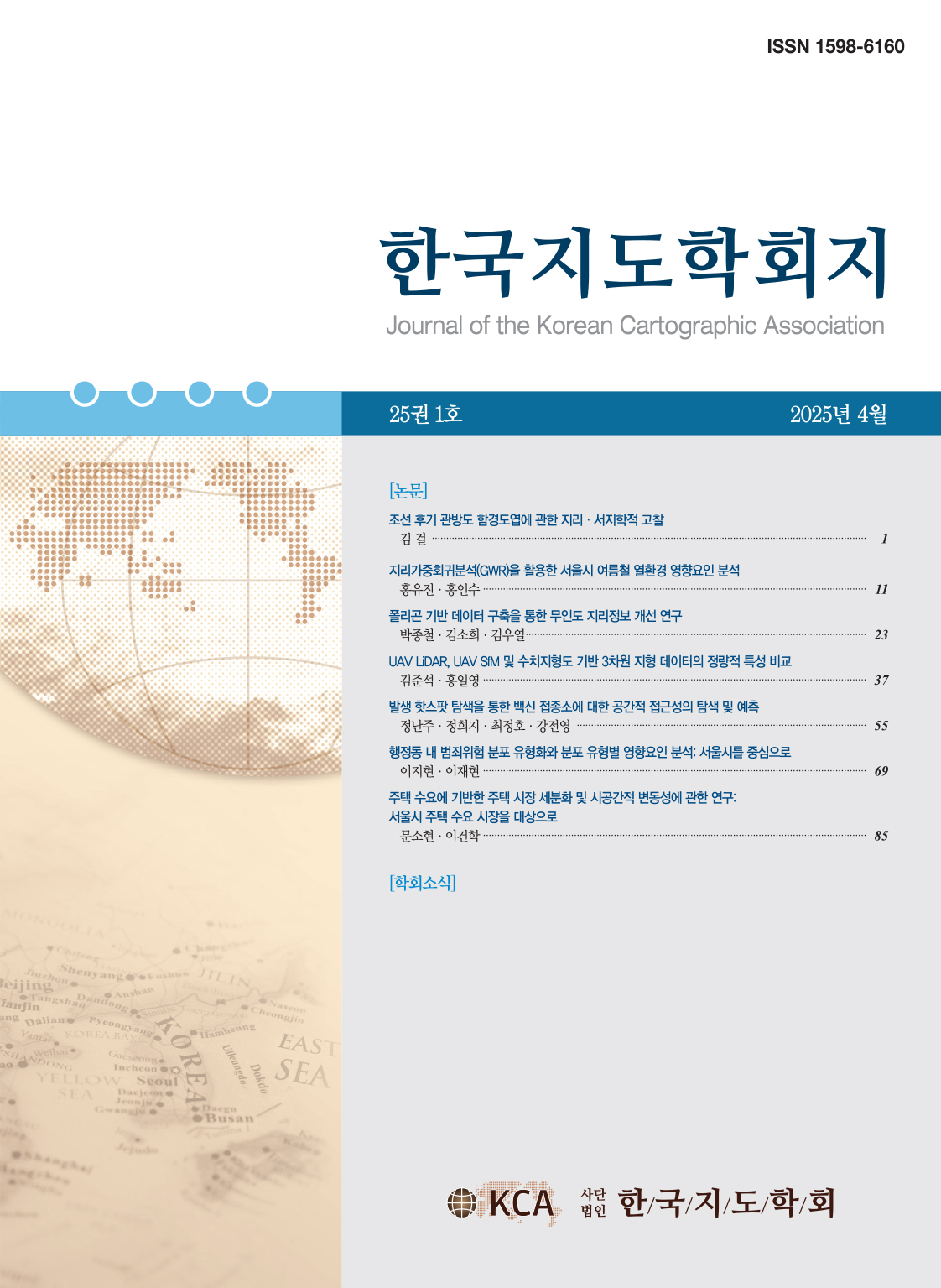Research Article
Abstract
References
Information
China has opened its doors to foreign countries from late 1970s, and it has experienced tremendous economic growth in recent years. Meanwhile, an economic-development gap between regions has emerged to be a socio-economic issue in the nation. This research investigated the spatio-temporal dynamics of economic growth, associated with Chinese border regions, using DMSP-OLS time-series imagery at the scales of neighboring countries, zones and cities. To do this, the sum of lights was calculated from the satellite images with inter-calibration, intra-annual calibration, and inter-annual calibration. In addition, subsequent spatio-temporal analyses were made on the basis of coefficient of variation, annual average growth rate, compound annual growth rate and SOL-weighted centroids. This study found the decrease of economic growth gap between border zones. On the contrary, it was also revealed that unequal city-level growth in economy still remains in border regions of China. Such a socio-economic problem might be influenced by geopolitical relationship between the nation and neighboring countries. Both DMSP-OLS and SNPP-VIIRS DNB nighttime imagery would need to be incorporated in future research for making spatio-temporal analysis spanned to the most recent year.
1970년대 말부터 지속적인 대외개방정책을 펼쳐온 중국은 최근 들어 비약적 경제성장을 이룩하였으나, 불균등 성장에 의한 지역 간 경제개발 격차의 문제점이 대두되고 있다. 이러한 현상을 고려하여 본 연구는 DMSP-OLS 영상자료를 활용하여 중국 접경지역의 접경국가별, 권역별 및 도시별 경제성장의 시·공간적 역동성을 고찰하였다. 이를 위해 상호보정, 연내보정, 연간보정 등 전처리 과정을 거친 영상자료로부터 빛합계지수를 도출하였다. 도시별 빛합계지수에 관한 변동계수, 연간성장률, 복합 연평균성장률의 시계열 추세와 빛합계지수 중심점의 시·공간적 변화패턴을 분석하였다. 본 연구의 결과에 따르면 중국 접경지역의 권역 간 경제개발 격차는 감소하였으나, 도시별 불균등은 여전한 문제로 나타났다. 이러한 결과는 중국과 인접 국가 간 지정학적 관계도 영향을 미쳤을 것으로 추정된다. 접경지역 경제성장의 시계열 변화를 최근까지 살펴보기 위해 향후 연구에는 2013년부터 제공되는 SNPP-VIIRS DNB 영상자료를 함께 활용해야 할 것이다.
- 곽복선, 2013, “중국 지역개발정책의 유형변화에 관한 연구,” CHINA 연구, 부산대학교 중국연구소, 15, 67-107.
- 김경숙, 2018, 「트럼프 시기 미중 관계: 갈등과 전망을 중심으로」, 서울: 국가안보전략연구원.
- 김민호, 2017, “DMSP OLS 야간 영상을 이용한 중국 랴오닝성 도시화의 시계열 분석,” 한국지도학회지, 17(3), 85-96.
- 김민호, 2014, “위성영상을 활용한 국내 빛공해 변화에 관한 연구,” 한국지도학회지, 14(1), 49-59.
- 김민호・지상현・정수열・이승철, 2017, “접경지역 빛합계 지수의 지정학·지경학적 함의: 중국 단둥시를 사례로,” 한국경제지리학회지, 20(3), 369-387.
- 김은화, 2014, “중국의 경제발전 시범구역 설립현황과 시사점,” 중국 금융시장 포커스 가을호.
- 김재관・주장완, 2010, “중국의 중앙아시아 지배전략과 정책에 관한 연구,” 제2차 중앙아시아 국내학술대회, 347-380.
- 김태형, 2012, “파키스탄의 대 강대국 외교: 대미 대중 관계를 중심으로,” 동서연구, 24(4), 5-35.
- 박광득, 2008, “중국의 개혁·개방정책 30년 성과와 전망,” 대한정치학회보, 16(1), 133-156.
- 박인성, 2010, “중국의 도시화 특성과 국토공간구조 형성 동향 고찰,” 서울도시연구, 11(2), 1-13.
- 송준・김수은・황윤섭, 2010, “중국의 지역별 수출과 경제성장 간의 영향관계 분석,” 통상정보연구, 12(2), 239-265.
- 신성원, 2014, 「중국의 대외정책과 주변국 관계」, 서울: 국립외교원 외교안보연구소.
- 오승렬, 2008, 「중국경제의 개혁·개방과 경제구조: 북한경제 변화에 대한 함의(연구총서 01-31)」, 서울: 통일연구원.
- 이기현・김애경・이영학, 2014, 「중국의 주변외교 전략 연구: 중국의 대북정책 결정에 대한 함의」, 서울: 통일연구원 국제전략연구센터.
- 이근・한동훈, 2007, 「중국 정부의 지역경제 발전 계획/전략 및 시사점」, 서울: 외교통상부.
- 이승신・이현태・현상백・나수엽・김영선・조고운・오윤미, 2017, 「중국의 일대일로 전략 평가와 한국의 대응방안」, 세종: 대외경제정책연구원.
- 이요한, 2016, 「라오스 신정부의 중국과 미국 사이의 외교적 포지셔닝」, EMERiCs 이슈분석, 세종: 대외경제정책연구원.
- 이종화, 2007, “중국 지역발전전략의 특징과 함의: 서부대개발·동북진흥·중부굴기전략을 중심으로,” 국가전략, 13(2), 57-85.
- 윤준상, 2010, “중국의 지역균형개발정책 효과 및 영향요인 분석,” 농촌지도와 개발, 17(2), 213-232.
- 장준영, 2012, 「미얀마 외교정책의 변화와 주요국과의 관계」, 서울: 대외경제정책연구원.
- 정재준, 2012, “위성영상분류와 식생지수를 이용한 도시지역 추출 비교 연구,” 한국지도학회지, 12(3), 35-44.
- 정주연, 2017, “중국의 경제적 불평등과 그 정치적 함의,” 차이나 브리핑 2017년 3월호.
- Chen, X. and Nordhaus, W.D., 2011, Using luminosity data as a proxy for economic statistics, PNAS, 108(21), 8589-8594.10.1073/pnas.1017031108
- Clark, H., Pinkovskiy, M., and Sala-i-Martin, X., 2018, China’s GPD growth may be understated, China Economic Review, https://doi.org/10.1016/j.chieco. 2018.10.010.10.1016/j.chieco. 2018.10.010.
- Croft, T.A., 1978, Nighttime images of the Earth from space, Scientific American, 239, 86-98.10.1038/scientificamerican0778-86
- Doll, C.N.H., Muller, J., and Morley, J.G., 2005, Mapping regional economic activity from night-time light satellite imagery, Ecological Economics, 57, 75-92.10.1016/j.ecolecon.2005.03.007
- Donaldson, D. and Storeygard, A., 2016, The view from above: applications of satellite data in economics, Journal of Economic Perspectives, 30(4), 171-198.10.1257/jep.30.4.171
- Elvidge, C.D., Cizano, P., Pettit, D.R., Arvesen, J., Sutton, P., Small, C., Nemani, R., Longcore, T., Rich. C., Safran, J., Weeks, J., and Ebener, S., 2007, The nightsat mission concept, International Journal of Remote Sensing, 28, 2645-2670.10.1080/01431160600981525
- Elvidge, C.D., Hsu, F.C., Baugh, K., and Ghosh, T., 2014, National trends in satellite observed lighting: 1992-2012, in Weng, Q., ed., Global Urban Monitoring and Assessment through Earth Observation, CRC Press, Boca Raton, 97-120.10.1201/b17012-9
- Fan, S., Kanbur, R., and Zhang, X., 2011, China’s regional disparities: experience and policy, Review of Development Finance, 1(1), 47-56.10.1016/j.rdf.2010.10.001
- Guerrero, V. and Mendoza, J.A., 2018, On measuring economic growth from outer space: a single country approach, Empirical Economics, https://doi.org/ 10.1007/s00181-018-1464-1.0.1007/s00181-018-1464-1.
- Hao, H.U., Shufang, W., and Yuejing, G.E., 2018, Regional differences of border geo-cities in China and the surrounding countries, Journal of Geographical Sciences, 28(3), 351-366.10.1007/s11442-018-1477-x
- He, C., Shi, P., Li, J., Chen, J., Pan, Y., Li, J., Zhuo, L., and Ichinose, T., 2006, Restoring urbanization process in China in the 1990s by using non-radiance-calibrated DMSP/OLS nighttime light imagery and statistical data, Chinese Science Bulletin, 51(13), 1614-1620.10.1007/s11434-006-2006-3
- Henderson, J.V., Storeygard, A., and Weil, D.N., 2012, Measuring economic growth from outer space, American Economic Review, 102(2), 994-1028.10.1257/aer.102.2.994
- Huang,. Q., Yang, Y., Li, Y., and Gao, B., 2016, A simulation study on the urban population of China based on nighttime light data acquired from DMSP/OLS, Sustainability, 8(6), 521.10.3390/su8060521
- Jones, D.C., Li, C.L., and Owen, A.L., 2003, Growth and regional inequality in China during the reform era, China Economic Review, 14(2), 186-200.10.1016/S1043-951X(03)00022-1
- Keola, S., Andersson, M., and Hall, O., 2015, Monitoring economic development from space: using nighttime light and land cover data to measure economic growth, World Development, 66, 322-334.10.1016/j.worlddev.2014.08.017
- Kim, M. and Choi, J., 2015, Spatio-temporal patterns of outdoor artificial nighttime lights exposure in the Republic of Korea between 1995 and 2010, Cartography and Geographic Information Science, 42(1), 69-78.10.1080/15230406.2014.987695
- Lessman, C. and Seidel, A., 2017, Regional inequality, convergence, and its determinants –a view from outer space, European Economic Review, 92, 110-132.10.1016/j.euroecorev.2016.11.009
- Liu, Z., He, C., Zhang, Q., Huang, Q., and Yang, Y., 2012, Extracting the dynamics of urban expansion in China using DSMP-OLS nighttime light data from 1992 to 2008, Landscape and Urban Planning, 106, 62-72.10.1016/j.landurbplan.2012.02.013
- Ma, T., Zhou, C., Pei, T., Haynie, S., and Fan, J., 2012, Quantitative estimation of urbanization dynamics using time series of DMSP/OLS nighttime light data: a comparative case study from China’s cities, Remote Sensing of Environment, 124, 99-107.10.1016/j.rse.2012.04.018
- Small, C., Pozzi, F., and Elvidge, C.D., 2005. Spatial analysis of global urban extent from DMSP-OLS night lights, Remote Sensing of Environment, 96, 277-291.10.1016/j.rse.2005.02.002
- Xu, T., Ma, T., Zhoug, C., and Zhou, Y., 2014, Characterizing spatio-temporal dynamics of urbanization in China using time series DMSP/OLS night light data, Remote Sensing, 6, 7708-7731.10.3390/rs6087708
- Zhang, L., Qu, G., and Wang, W., 2015, Estimating land development time lags in China using DMSP/OLS nighttime light image, Remote Sensing, 7, 882-904.10.3390/rs70100882
- Publisher :The Korean Cartographic Association
- Publisher(Ko) :한국지도학회
- Journal Title :Journal of the Korean Cartographic Association
- Journal Title(Ko) :한국지도학회지
- Volume : 19
- No :2
- Pages :65~77
- DOI :https://doi.org/10.16879/jkca.2019.19.2.065



 Journal of the Korean Cartographic Association
Journal of the Korean Cartographic Association





